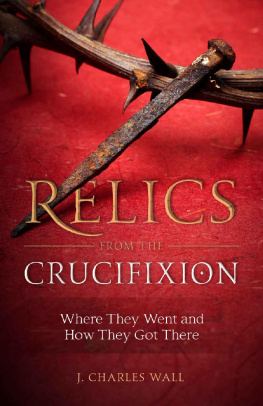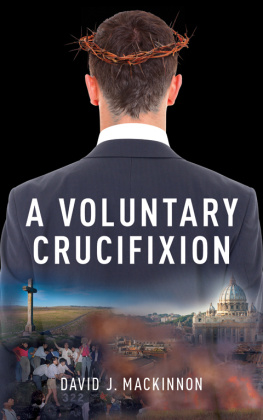Dr. C. Truman Davis - The Crucifixion
Here you can read online Dr. C. Truman Davis - The Crucifixion full text of the book (entire story) in english for free. Download pdf and epub, get meaning, cover and reviews about this ebook. genre: Detective and thriller. Description of the work, (preface) as well as reviews are available. Best literature library LitArk.com created for fans of good reading and offers a wide selection of genres:
Romance novel
Science fiction
Adventure
Detective
Science
History
Home and family
Prose
Art
Politics
Computer
Non-fiction
Religion
Business
Children
Humor
Choose a favorite category and find really read worthwhile books. Enjoy immersion in the world of imagination, feel the emotions of the characters or learn something new for yourself, make an fascinating discovery.
- Book:The Crucifixion
- Author:
- Genre:
- Rating:5 / 5
- Favourites:Add to favourites
- Your mark:
- 100
- 1
- 2
- 3
- 4
- 5
The Crucifixion: summary, description and annotation
We offer to read an annotation, description, summary or preface (depends on what the author of the book "The Crucifixion" wrote himself). If you haven't found the necessary information about the book — write in the comments, we will try to find it.
The Crucifixion — read online for free the complete book (whole text) full work
Below is the text of the book, divided by pages. System saving the place of the last page read, allows you to conveniently read the book "The Crucifixion" online for free, without having to search again every time where you left off. Put a bookmark, and you can go to the page where you finished reading at any time.
Font size:
Interval:
Bookmark:
BY PETRUS VERMAAK
The Crucifixion
by Dr. C. Truman Davis
A medical explanation of what Jesus endured on the day He died
By Dr. C. Truman Davis*
A Physician Analyzes the Crucifixion.
From New Wine Magazine, April 1982.
Originally published in Arizona Medicine ,
March 1965, Arizona Medical Association.
Several years ago I became interested in the physical aspects of the passion, or suffering, of Jesus Christ when I read an account of the crucifixion in Jim Bishop's book, The Day Christ Died. I suddenly realized that I had taken the crucifixion more or less for granted all these years - that I had grown callous to its horror by a too-easy familiarity with the grim details. It finally occurred to me that, as a physician, I did not even know the actual immediate cause of Christ's death. The gospel writers do not help much on this point. Since crucifixion and scourging were so common during their lifetimes, they undoubtedly considered a detailed description superfluous. For that reason we have only the concise words of the evangelists: "Pilate, having scourged Jesus, delivered Him to them to be crucified ... and they crucified Him."
Despite the gospel accounts silence on the details of Christ's crucifixion, many have looked into this subject in the past. In my personal study of the event from a medical viewpoint, I am indebted especially to Dr. Pierre Barbet, a French surgeon who did exhaustive historical and experimental research and wrote extensively on the topic.
An attempt to examine the infinite psychic and spiritual suffering of the Incarnate1 God in atonement for the sins of fallen man is beyond the scope of this article. However, the physiological and anatomical aspects of our Lord's passion we can examine in some detail. What did the body of Jesus of Nazareth actually endure during those hours of torture?
Gethsemane
The physical passion of Christ began in Gethsemane. Of the many aspects of His initial suffering, the one which is of particular physiological interest is the bloody sweat. Interestingly enough, the physician, St. Luke, is the only evangelist to mention this occurrence. He says, "And being in an agony, he prayed the longer. And his sweat became as drops of blood, trickling down upon the ground" (Luke 22:44 KJV).
Every attempt imaginable has been used by modern scholars to explain away the phenomenon of bloody sweat, apparently under the mistaken impression that it simply does not occur . A great deal of effort could be saved by consulting the medical literature. Though very rare, the phenomenon of hematidrosis , or bloody sweat, is well documented . Under great emotional stress, tiny capillaries in the sweat glands can break, thus mixing blood with sweat. This process alone could have produced marked weakness and possible shock.
Although Jesus' betrayal and arrest are important portions of the passion story, the next event in the account which is significant from a medical perspective is His trial before the Sanhedrin and Caiaphas, the High Priest. Here the first physical trauma was inflicted . A soldier struck Jesus across the face for remaining silent when questioned by Caiaphas. The palace guards then blindfolded Him, mockingly taunted Him to identify them as each passed by, spat on Him, and struck Him in the face.
Before Pilate
In the early morning, battered and bruised, dehydrated, and worn out from a sleepless night, Jesus was taken across Jerusalem to the Praetorium of the Fortress Antonia, the seat of government of the Procurator of Judea, Pontius Pilate. We are familiar with Pilate's action in attempting to shift responsibility to Herod Antipas, the Tetrarch of Judea. Jesus apparently suffered no physical mistreatment at the hands of Herod and was returned to Pilate. It was then, in response to the outcry of the mob, that Pilate ordered Barabbas released and condemned Jesus to scourging and crucifixion.
Preparations for Jesus' scourging were carried out at Caesar's orders. The prisoner was stripped of His clothing and His hands tied to a post above His head. The Roman legionnaire stepped forward with the flagrum , or flagellum, in his hand. This was a short whip consisting of several heavy, leather thongs with two small balls of lead attached near the ends of each. The heavy whip was brought down with full force again and again across Jesus' shoulders, back, and legs. At first the weighted thongs cut through the skin only. Then, as the blows continued, they cut deeper into the subcutaneous tissues, producing first an oozing of blood from the capillaries and veins of the skin and finally spurting arterial bleeding from vessels in the underlying muscles.
The small balls of lead first produced large deep bruises that were broken open by subsequent blows. Finally, the skin of the back was hanging in long ribbons, and the entire area was an unrecognizable mass of torn, bleeding tissue. When it was determined by the centurion in charge that the prisoner was near death , the beating was finally stopped.
Mockery
The half-fainting Jesus was then untied and allowed to slump to the stone pavement, wet with his own blood . The Roman soldiers saw a great joke in this provincial Jew claiming to be a king. They threw a robe across His shoulders and placed a stick in His hand for a scepter. They still needed a crown to make their travesty complete. Small flexible branches covered with long thorns, commonly used for kindling fires in the charcoal braziers in the courtyard, were plaited into the shape of a crude crown. The crown was pressed into his scalp and again there was copious bleeding as the thorns pierced the very vascular tissue. After mocking Him and striking Him across the face, the soldiers took the stick from His hand and struck Him across the head, driving the thorns deeper into His scalp. Finally, they tired of their sadistic sport and tore the robe from His back. The robe had already become adherent to the clots of blood and serum in the wounds, and its removal, just as in the careless removal of a surgical bandage, caused excruciating pain. The wounds again began to bleed.
Golgotha
In deference to Jewish custom, the Romans apparently returned His garments. The heavy patibulum of the cross was tied across His shoulders. The procession of the condemned Christ, two thieves, and the execution detail of Roman soldiers headed by a centurion began its slow journey along the route which we know today as the Via Dolorosa.
In spite of Jesus' efforts to walk erect, the weight of the heavy wooden beam, together with the shock produced by copious loss of blood, was too much. He stumbled and fell. The rough wood of the beam gouged into the lacerated skin and muscles of the shoulders. He tried to rise, but human muscles had been pushed beyond their endurance. The centurion, anxious to proceed with the crucifixion, selected a stalwart North African onlooker, Simon of Cyrene, to carry the cross. Jesus followed, still bleeding and sweating the cold, clammy sweat of shock. The 650-yard journey from the Fortress Antonia to Golgotha was finally completed. The prisoner was again stripped of His clothing except for a loin cloth which was allowed the Jews.
The crucifixion began. Jesus was offered wine mixed with myrrh, a mild analgesic, pain- reliving mixture. He refused the drink. Simon was ordered to place the patibulum on the ground, and Jesus was quickly thrown backward, with His shoulders against the wood. The legionnaire felt for the depression at the front of the wrist. He drove a heavy, square wrought-iron nail through the wrist and deep into the wood. Quickly, he moved to the other side and repeated the action, being careful not to pull the arms too tightly, but to allow some flexion and movement. The patibulum was then lifted into place at the top of the stipes , and the titulus reading "Jesus of Nazareth, King of the Jews" was nailed into place.
Font size:
Interval:
Bookmark:
Similar books «The Crucifixion»
Look at similar books to The Crucifixion. We have selected literature similar in name and meaning in the hope of providing readers with more options to find new, interesting, not yet read works.
Discussion, reviews of the book The Crucifixion and just readers' own opinions. Leave your comments, write what you think about the work, its meaning or the main characters. Specify what exactly you liked and what you didn't like, and why you think so.










